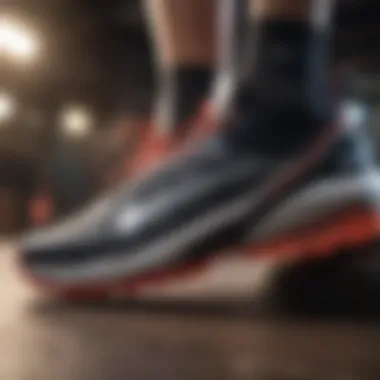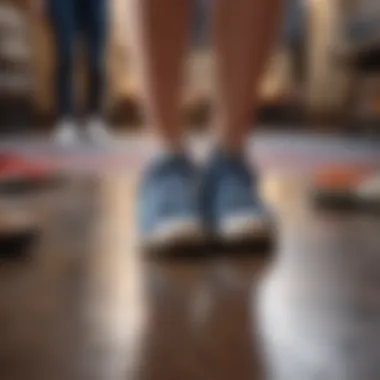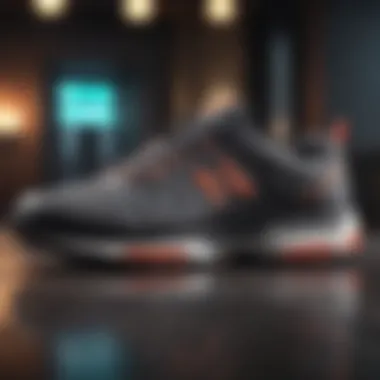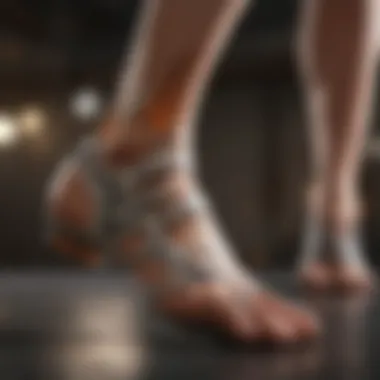Choosing Comfortable Shoes for Long Hours of Standing


Intro
Long periods of standing can impose considerable strain on the body. Foot health often comes first, affecting overall well-being, comfort, and productivity. Selecting the right type of footwear plays a vital role in ensuring comfort and reducing long-term health issues. This article serves as a guide, detailing essential attributes of comfortable shoes suitable for standing extensively.
The Importance of Proper Footwear
Footwear that supports your feet can influence physical health significantly. Foot pain, fatigue, and various musculoskeletal issues can arise from wearing unsuitable shoes. It is crucial to recognize that not all footwear meets the requirements of individuals who stand for long hours.
When choosing shoes for long periods of standing, consider attributes like arch support, cushioning, and fit. Good shoes not only provide comfort but also enhance productivity by minimizing distractions caused by discomfort.
Key Features to Look For
When evaluating shoes, focus on:
- Arch Support: Shoes should support the natural arch of your foot. This reduces strain and discomfort.
- Cushioning: Ample cushioning absorbs impact. Look for materials that provide shock absorption for both the heel and forefoot.
- Breathability: Shoes made from breathable materials can help in keeping feet dry and comfortable.
- Fit: Ensure that the shoes fit correctly. A proper fit minimizes movement inside the shoe, reducing the risk of blisters and soreness.
Recommendations Across Different Contexts
In various work environments, there are specific recommendations for footwear:
- Healthcare Professionals: Nurses and doctors often spend long shifts on their feet. Brands like Dansko and Hoka One One offer clogs with solid arch support and cushioning.
- Retail Workers: Employees in retail may benefit from lightweight shoes with slip-resistant soles, such as Skechers or New Balance styles.
- Industrial Workers: For those in environments with potential hazards, choosing shoes with steel toes and supportive midsoles is essential. Brands like Caterpillar provide functional options.
Maintaining Foot Health
To keep your feet in good condition:
- Stretching: Regular stretching exercises help maintain flexibility in feet and legs.
- Footwear Rotation: Avoid wearing the same pair daily. Alternate shoes to allow them to decompress and promote better foot health.
- Regular Checks: Monitor your feet for any signs of irritation or discomfort. Early intervention can prevent long-lasting issues.
"Proper footwear is not just a luxury—it's a necessity for anyone who stands for long periods.”
Overall, understanding the foundational elements of footwear and its impact on health can guide decisions effectively. This knowledge ensures that individuals remain supported and comfortable, contributing positively to their daily lives.
Preface to Comfortable Footwear
The choice of comfortable footwear is paramount for those who stand for extended periods. Comfortable shoes can significantly enhance one's overall health and productivity. This section delves into the critical elements that define comfort in shoes and addresses the various considerations that come into play for individuals in demanding roles. It is essential to understand how the right footwear not only alleviates discomfort but also prevents long-term injuries and promotes a healthier lifestyle.
Understanding the Importance of Footwear
Footwear serves as the foundation for our daily activities. When selecting shoes, it is important to consider their intended purpose. Shoes meant for leisure activities differ drastically from those intended for professional environments where long hours of standing are common.
The significance of comfortable footwear lies in its direct impact on physical health. Poorly designed shoes can lead to conditions such as plantar fasciitis and other musculoskeletal issues. In addition, improper footwear may compromise posture, leading to back and joint problems. On the other hand, well-constructed shoes provide support, alignment, and stability, which can enhance both efficiency and comfort throughout the day.
Challenges of Standing for Extended Periods
Standing for long hours presents distinct challenges. The human body is not naturally designed for prolonged static positions. When individuals remain upright for extended durations, several problems can arise.
- Fatigue: Standing for extended periods causes muscles to tire more quickly, eventually leading to overall fatigue.
- Circulation Issues: Blood flow can become restricted in the feet and legs, potentially leading to swelling and varicose veins over time.
- Joint Pain: Prolonged pressure on the joints—especially in the knees and hips—can cause discomfort or chronic pain.
- Foot Pain: Improper footwear may result in blisters, calluses, or other painful conditions that affect mobility.


Choosing the right comfortable footwear is not just a matter of preference; it is a crucial aspect of maintaining health and well-being.
These challenges underscore the importance of investing in shoes that provide comfortable support. To navigate the demands of standing jobs, understanding which features contribute to comfort can guide individuals toward making informed decisions on their footwear.
Anatomy of Comfortable Shoes
Understanding the anatomy of comfortable shoes is crucial for anyone who stands for long periods. Each component plays a vital role in providing the necessary support and comfort. A well-constructed shoe can mitigate many issues caused by prolonged standing, such as fatigue, pain, and other related ailments.
Materials Used in Comfortable Footwear
The choice of materials is fundamental in the design of footwear. Various materials can significantly influence the shoe's overall comfort and durability. Common materials include:
- Leather: Known for its durability and ability to mold to the foot shape, leather offers a better fit over time.
- Mesh: This provides breathability, allowing air circulation that helps keep the foot cool and dry during long shifts.
- Synthetic materials: Often lighter and more flexible, these materials can offer a balance between support and weight.
In addition, eco-friendly options are emerging in the market, appealing to those concerned with sustainability. The right material contributes to a shoe that can absorb impact without adding unnecessary weight.
The Role of Cushioning and Support
Cushioning is arguably one of the most vital aspects of a functional shoe for extended standing. Adequate cushioning can alleviate pressure on the feet, reducing the risk of discomfort and injury. Key elements include:
- Insoles: High-quality insoles can provide additional arch support and comfort.
- Midsole technology: Innovations in midsole design offer varying degrees of firmness and shock absorption, allowing for customized comfort.
- Padding: Strategic padding around heels and forefoot can enhance comfort.
Having the right cushioning helps distribute weight evenly across the foot, reducing localized pressure points. This not only improves comfort but can enhance overall productivity and well-being.
Sole Structure: Importance of Flexibility and Durability
A shoe’s sole structure heavily influences its performance in terms of flexibility and durability. An ideal sole should strike a balance between being stiff enough to provide support while also flexible enough to allow natural foot movement. Consider the following aspects:
- Outsole material: Rubber outsoles are often preferred for their grip and durability. They help prevent slipping, especially in environments like kitchens or hospitals.
- Flex grooves: These grooves allow for better range of motion while walking, contributing to a more natural gait.
- Heel design: A lower heel helps maintain a stable posture and decreases the risk of strain on the legs and back.
Ultimately, a well-designed sole contributes to the shoe's ability to endure long working hours while ensuring comfort and decreasing the risk of injury during extended standing.
Key Features to Look for in Shoes
Selecting the right shoes for prolonged periods of standing is not just about comfort; it’s about maintaining overall health and function. Key features in footwear can dramatically influence welfare, productivity, and comfort. Evaluating these features helps in choosing footwear that reduces strain and enhances well-being. When individuals are on their feet often, the demand on their lower limbs increases. Thus, analyzing the right elements becomes essential to prevent discomfort and potential long-term damage.
Arch Support: Why It Matters
Arch support is fundamental in maintaining proper foot alignment. When standing for extended time, it is crucial that the shoe provides the right support to the arch. Insufficient arch support may lead to plantar fasciitis or other foot conditions. Arch support helps distribute weight evenly across the foot, reducing pressure points. When selecting shoes, one should ensure that the arch support complements their foot type. Custom arch support may also be necessary for those with specific foot conditions.
Breathability in Footwear
Breathability is often an underestimated factor in choosing comfortable shoes. Good ventilation within the shoe allows moisture and heat to escape, keeping feet dry and comfortable. This feature is particularly important for people who work in warm environments or are prone to sweaty feet. Mesh materials often provide a breathability advantage, enabling air circulation around the foot. This can prevent unpleasant odors and skin irritations, promoting foot health. When shopping for shoes, ensure that the materials used allow adequate airflow.
Weight of the Shoe: Finding the Right Balance
The weight of the shoe can impact fatigue levels, especially during long hours of standing. Lightweight footwear minimizes the effort required for movement, helping to reduce fatigue. Heavy shoes add unnecessary strain, often leading to discomfort after extended use. Aim for shoes that provide a balance between lightweight construction and adequate protection. It’s advisable to try on shoes and assess how they feel when standing or walking. A shoe that feels considerably heavy may not serve well for prolonged wear.
Adjustable Features: Straps and Laces


Adjustable features such as straps and laces allow for a personalized fit. Proper fit is crucial to ensure the shoe remains securely on the foot without causing pinching or slipping. Too loose a fit can lead to blisters, while too tight a fit can restrict blood flow. Look for shoes that offer adjustable elements, as they can accommodate various foot shapes and sizes. This adaptability enhances comfort and support while standing for long periods. It is smart to try out the adjustments while walking to see how well they function under pressure.
Types of Shoes Suitable for Long Standing
Choosing the right type of shoe for long periods of standing is fundamental for maintaining foot health and overall well-being. Many people do not realize that the wrong footwear can lead to discomfort and even long-term injuries. Various professions and daily activities dictate specific footwear needs, making it vital to understand the distinct benefits of different options available in the market.
The right shoe can provide adequate support, cushioning, and stability. This proper footwear selection can alleviate stress on your feet, reducing fatigue and discomfort. Wearing shoes designed for prolonged standing fosters better posture and can enhance productivity during work hours. Below is a discussion of key categories of shoes to consider for those who find themselves on their feet for extended periods.
Athletic Shoes: Versatile and Supportive
Athletic shoes are often known for their balance of support and flexibility. They are designed for movement, making them suitable for different settings, from casual outings to more intensive activities. These shoes feature features like padded collars and tongue areas which make them more comfortable for standing. Furthermore, many athletic shoes provide an arch and heel support that helps distribute weight evenly, preventing strain.
When selecting athletic shoes, consider the type of activities you engage in most frequently. Look for brands that prioritize cushioning, such as Nike or New Balance.
"A well-cushioned shoe can make a significant difference in how your feet feel at the end of the day."
Professional Footwear for Work Environments
For professionals in specific industries, investing in work-specific footwear is paramount. Healthcare workers, teachers, and retail employees require shoes that withstand long hours of wear while providing a serious level of support and comfort.
Look for features such as slip-resistant soles and reinforced toes in professional shoes. Brands like Clarks and Skechers provide several models designed specifically for this type of usage, ensuring that individuals achieve comfort while also complying with necessary safety standards.
It's important to pick footwear that promotes breathability, allowing your feet to stay dry and comfortable throughout the day. The right professional shoe can also resonate with your workplace environment, allowing for a polished appearance without sacrificing comfort.
Stylish Yet Comfortable Options
Finding stylish options that are also comfortable can be challenging. However, more brands are recognizing the need for shoes that align with both aesthetics and functionality. Many modern designs feature arch support, cushioned soles, and flexible materials that improve comfort while still being visually appealing.
Consider looking into options from brands like Vionic or Dansko, which focus on aesthetics while enhancing comfort for standing long periods. It is possible to find shoes that work for professional settings or casual outings, ensuring you never need to sacrifice style for comfort.
Recommendations for Various Settings
Selecting the right footwear is crucial for individuals across different professions. This section outlines specific considerations for various settings where prolonged standing is prevalent. The right shoes not only enhance comfort but also play a vital role in preventing foot-related issues that can arise from daily stresses. Understanding the unique demands of each environment allows one to make informed decisions, ultimately contributing to better health and productivity.
Footwear for Healthcare Professionals
Healthcare professionals often face long shifts where standing is a necessity. Comfortable shoes are essential in this environment, as they need to provide extensive support and durability. Key considerations for healthcare footwear include:
- Arch support: Helps to distribute weight evenly and reduce stress on foot joints.
- Shock absorption: Vital to lessen impact when walking on hard surfaces, which is common in hospitals.
- Breathability: Ensures feet stay dry and comfortable throughout long hours.
Some recommended brands include Dansko and Skechers, which are well-regarded for their ergonomic designs tailored for health workers.
Best Choices for Retail Workers
Retail workers spend hours on their feet, interacting with customers while managing inventory. Comfortable shoes can improve performance and reduce fatigue. When selecting shoes for retail environments, consider the following:
- Flexibility: Shoes should allow for natural foot movement as one shifts positions frequently.
- Slip resistance: Important for preventing accidents in bustling environments, especially where spills may occur.
- Style: Shoes should also align with company dress codes while offering comfort.
Nike and New Balance provide a good selection of both supportive and stylish options suitable for retail settings.


Options for Hospitality Industry Workers
In the hospitality industry, workers often need to be on their feet for hours, whether catering events or serving in restaurants. Therefore, selecting appropriate footwear is critical. Important aspects to consider include:
- Cushioning: Reduces discomfort from standing and walking extensively.
- Water resistance: Beneficial for those working in environments where spills are likely, such as kitchens or bars.
- Easy to clean: Footwear should be maintainable, given the nature of the job.
Popular choices include Dr. Scholl's and Crocs, known for their practicality and comfort in demanding workspaces.
"Choosing the right footwear can greatly impact both well-being and performance in any profession involving prolonged standing."
In summary, making informed choices about footwear based on specific work environments can lead to significant improvements in comfort and productivity. By understanding the requirements of various settings, workers can select options that will provide them the support they need.
Maintaining Foot Health
Maintaining foot health is an essential aspect of overall well-being, especially for those who stand for extended periods. Our feet are foundational to mobility and comfort. Neglecting foot health can result in discomfort, pain, and potential long-term issues. Thus, awareness of proper care routines and recognizing signs of fatigue or injury is important. By prioritizing foot health, individuals can enhance their productivity and quality of life.
Proper Foot Care Routine
Establishing a proper foot care routine can significantly impact foot health. Regular maintenance encourages circulation, improves comfort, and helps to prevent ailments. Key practices include:
- Daily Cleaning: Clean the feet daily with soap and water. Dry them thoroughly, especially between the toes, to prevent fungal infections.
- Moisturizing: Apply a suitable moisturizer to prevent dryness and cracking of the skin, but avoid the areas between the toes.
- Regular Nail Care: Trim the toenails straight across to prevent ingrown toenails. Keep nails clean and, if necessary, file edges.
- Footwear Selection: Choose shoes that provide adequate support and fit properly. Avoid tight shoes that can exacerbate foot problems.
- Orthotic Inserts: Consider orthoitcs if you experience discomfort. They can provide additional support and cushioning.
In addition, it is important to take breaks and allow feet to rest when possible. Simple exercises like stretching or rolling the feet on a ball can also improve circulation.
Signs of Foot Fatigue and Injury
Recognizing signs of foot fatigue and injury is crucial for timely intervention. Ignoring symptoms can lead to severe complications. Common indicators include:
- Pain: Persistent discomfort in any part of the foot should not be ignored. This can vary from dull aches to sharp pains.
- Swelling: Increased visibility of swelling may indicate ongoing issues. Pay particular attention to the ankles and the tops of the feet.
- Changes in Skin Color or Temperature: If you notice differences in skin color or feel increased warmth or coolness, these might be signs of circulation problems.
- Numbness or Tingling: These sensations can indicate nerve compression or damage and warrant immediate attention.
- Reduced Mobility: Difficulty moving toes or the foot can point to injury or strain. If such issues arise, consulting a healthcare professional is best.
By adhering to a proper foot care routine and recognizing symptoms early, individuals can maintain healthier feet, thereby improving their overall comfort and productivity.
"Feet should be treated with the same care we give our heart and mind; their health directly affects our daily movement and quality of life."
In summary, both routine care and attentiveness to symptoms are keys to maintaining foot health. Prioritize where you can, and listen to your body. The investment in foot health pays dividends, especially for those on their feet for long hours.
The End
In this article, we have explored the intricacies of selecting shoes designed for those who find themselves standing for long periods. Comfortable footwear is not merely a luxury; it is a necessity that affects both health and productivity in everyday situations. Individuals who spend hours on their feet can experience various health issues, from chronic pain to fatigue if their footwear fails to provide adequate support and comfort.
Recap of Key Considerations
The importance of key features in shoes is paramount. Features such as arch support, breathability, cushioning, and adjustable elements cannot be overlooked. Consideration of the materials used and the overall sole structure contributes significantly to overall comfort.
These elements work together to provide a foundation that minimizes stress on the body. The following are crucial takeaways from the article:
- Arch Support: Essential for maintaining foot alignment and preventing strain.
- Cushioning: Enhances comfort levels and absorbs shock.
- Breathability: Keeps feet dry and reduces discomfort during long hours of standing.
- Weight: A lightweight shoe reduces fatigue over time.
- Adjustable Features: Allow for a personalized fit, catering to individual foot shapes.
"Choosing the right footwear can have profound impacts on one’s health and comfort, particularly for those who are on their feet for extended times."
Encouragement for Informed Choices
As you consider your next footwear purchase, understanding the unique needs dictated by your environment is crucial. Evaluate your lifestyle and habits. Professionals such as healthcare workers, retail employees, and others in similar roles should take special care to select shoes that align with their daily demands. By prioritizing comfort, wearers can prevent discomfort and potential injury.
Consider consulting with footwear specialists or podiatrists if unsure about your specific needs. Investing in suitable shoes pays dividends. Better foot health can lead to increased productivity and improved overall physical well-being. The journey toward better health starts at the ground up with appropriate footwear.
By making informed footwear choices, we can significantly enhance our daily experiences and maintain our health in the long run.







